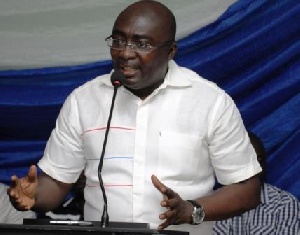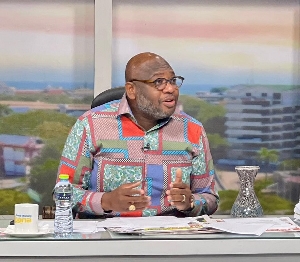Dr Mahamudu Bawumia has said 98 per cent of a 12-page statement issued by the Minister of Communication, Dr Edward Omane Boamah, to propagate government’s achievements as far as improving the well-being of Ghanaians is concerned, did not come from the International Monetary Fund’s World Economic Outlook.
The statement released by the government on Tuesday June 7 said the well-being of Ghanaians has improved under President John Mahama.
“Latest data on per capita income from the International Monetary Fund (IMF, World Economic Outlook, 2016) puts Ghana’s GDP per capita in current terms in the year 2015 at US$1,340.4. This represents 5.9% increase over the 2008 figure of US$1,266.1.
“Our current per capita income is also higher than that of Cote d’Ivoire (US$1,314.7), Senegal (US$913.0)”, the government’s statement said, adding: “We believe human development is a more encompassing and comprehensive way to conceptualise development, as it puts people first. In this light, the government acknowledges the gains made over the last few years in major human development indicators.”
“Ghana achieved the Millennium Development Goal 1 target of reducing the proportion of poor people by half by 2015 in 2013 – two clear years ahead of the deadline”, the statement said.
The release said the Mahama administration is “committed to working harder to bring further relief to the citizenry and join the group of high human development countries”.
Speaking to Bernard Avle on Accra-based Citi FM on Friday June 10, Dr Bawumia said: “This report that the Minister released, we were told that this is the IMF’s World Economic Outlook giving the government significant progress. I read the IMF’s World Economic Outlook and I looked at the Minister’s statement – the 12-page statement of the Minister; in fact my impression initially when I heard it was that the Minister’s statement was coming out of the IMF’s report, but 91 per cent of the Minister’s statement is not in the World Economic Outlook. So all they say is that the IMF says we’ve made progress and as I said, there are two parts of this statement in the world Economic Outlook that relates to Ghana, one says that Ghana will see a marginal increase in growth from 3.5 per cent to 4.5 per cent – that’s the first part – that’s all it says. Then from this particular statement, this one sentence, you generate a 12-page report.”
“What he’s given is the government’s usual propaganda about what they have done in education, health and so on,” the former Deputy Governor of the Bank of Ghana said.
According to him, no one government can claim credit for progress made with regard to human development in the country.
Read the government’s full statement below:
Government committed to sustaining significant gains in human development
Ghana has achieved significant progress on the economic front.
Latest data on per capita income from the International Monetary Fund (IMF, World Economic Outlook, 2016) puts Ghana’s GDP per capita in current terms in the year 2015 at US$1,340.4.This represents 5.9% increase over the 2008figure of US$1,266.1.
Our current per capita income is also higher than that of Cote d’Ivoire (US$1,314.7), Senegal (US$913.0) and Kenya (US$1,338.5).
This notwithstanding, President Mahama’s government takes the position that mere economic growth and its associated indicators are necessary but not sufficient measurements of human well-being. We believe Human development is a more encompassing and comprehensive way to conceptualise development as it puts people first. In this light government acknowledges the gains made over the last few years in major human development indicators.
Ghana achieved the Millennium Development Goal 1 target of reducing the proportion of poor people by half by 2015 in 2013- a clear two years ahead of the deadline. A recent World Bank study, “Poverty Reduction in Ghana: Progress and Challenges” supports this.
Beyond the above, other recognised benchmarks show significant improvements owing largely to the unprecedented investments into critical sectors such as health, education, water provision among others.
EDUCATION
Generally, Ghana‘s education system ranks among the best on the African Continent. The University of Ghana was recently ranked the 7th best University in Africa by the Times Higher Education. According to the UNDP (2015), Ghana’ s mean years in school (7.0 years) is higher and better than that of Kenya (6.3 years), Nigeria (5.9 years) Cote d’ivoire (4.3 years) and Senegal (2.5 years).
Improvement has also been reported in the Adult Literacy rate which increased from 50.7% in the year 2008 to 76.6% in 2015.More impressive is the trend in Youth Literacy which more than doubled between 1991/92 and 1998/99,from 21.9% to 55.8%. Thereafter a further increase to 64.8% was reported in 2005/06 before it took a quantum leap to 80.5% in 2012/2013.
Ghana has the highest school enrolment rate in West Africa with over 90% of eligible school children currently in school. As of the 2014/15 academic year a total of 9,202,894 pupils/students were enrolled in 57,293 education institutions from the Kindergarten stage to Tertiary level. This represents an increase of 2,164,156 or 30.74% over enrolment in the 2008/9 academic year.
Important benchmarks such as gender parity and completion rates are also improving. Gender parity which measures the ratio of girls to boys currently stands at 0.96 at the primary level and 0.91 at the JHS level; compared to 0.92 and 0.85 respectively in the 2008/9 academic year.
As far as completion rates are concerned, 99.6%of pupils enrolled at the primary school level complete while 73.5% of JHS students complete, up from 66% in 2008/9 academic year. The improvements observed in the indices above are as a result of prudent and strategic investments into social infrastructure and support systems actively pursued by government. From the end of 2008, Ghana has expanded the School Feeding Programme from 441,189 pupils to 1,693,000. The programme which began with a grant from the Netherlands government is now fully funded by the Government of Ghana.
This policy supported by vigorous expansion in school infrastructure such as completing and replacing 1,614 “schools under trees” since 2009 and the supply of teaching andlearning materials nationwide underlie the increasing enrolment and retention rates at the basic level from 2009.
At the secondary level, the rolling out of programmes such as the Secondary Education Improvement Programme (expanding and improving the qualityof 125 additional senior high schools in deprived communities), commencement f the progressively free secondary education policy in September 2015, the ongoing provision of scholarships for over 10,400 needy but brilliant students, as well as incentives to keep Ghanaian girls in senior high school have played a major role in expanding access and quality since 2009.
Specific interventions in various departments and schools apart from improving access have also enhanced research, teaching and learning on various campuses. Some of the notable examples arethe new Laboratories for the Petroleum Engineering Department of KNUST and the Engineering departments of the Polytechnics in Takoradi and Ho among others. The new ultramodern edifice for the Hospitality, Catering and Management Institute at the Sunyani Polytechnic and the new Engineering Faculty building at Koforidua Polytechnic are also part ofthe numerous contributory factors driving the gains made so far in the tertiary education sub sector.
New universities- University of Health and Allied Sciences (UHAS)and the University of Energy and Natural Resources- have also been opened in the Volta and the Brong Ahafo regions respectively and are being supported aggressively to expand their reach.
Teacher Education
Government’s assessment of the Teacher Education landscape revealed a number of problems that hindered the attainment of critical goals necessary for quality education. First, we noticed the glaring inequities in terms of the level of training. Ghana had two streams of teachers being trained.
Those trained in Universities such as University of Cape Coast, University of Education, Winneba among others and those trained in what we used to call Teacher Training Colleges. This led to disparities in the certificates obtained from the two different sets of institutions for graduates who essentially were expected to perform the same task- impart knowledge unto the Ghanaian pupil/student.
Government converted all the 38 existing Teacher Training Colleges into tertiary institutions, The Colleges of Education, to make them degree-awarding institutions.
The second challenge diagnosed was the inequity in funding Teacher Education. Whereas students at the University of Education Winneba (UEW) and the University of Cape Coast (UCC) etc. also being trained as teachers relied on students loans to support their education, those in the erstwhile Teacher Training Colleges were given monthly allowances.
The cost implications for the National budget over the years, compelled governments to scale down the number of students the Colleges of Education could admit in a year through the imposition of an obnoxious quota system. This system meant that even highly qualified SHS graduates willing and able to enrol as teacher trainees were denied access because the Colleges of Education could not admit them. The obnoxious and discriminatory “quota system” had definitely and permanently become a binding constraint.
Government discovered that some Teacher Training Colleges were in fact operating at less than 40% of their full capacity while thousands of eligible students were denied access, (they literally sat at home). There was the need for a government to act decisively in order to redress this unjust and unfair imbalance.
Government therefore swapped the teacher trainee allowance with the Student Loan Scheme operated by the Students Loan Trust.
In this swap process we first ensured that continuing students were not affected by the new policy. Implementation began with fresh students.So far, thousands of students in our Colleges of Education have since accessed the students loan to finance their education.
Secondly, we maintained the feeding grants for Colleges of Education making them the only tertiary institutions where feeding is provided. In March this year, government released an amount of GHC62.7 million to cater for the feeding of students in all Colleges of Education.
Thirdly, we have pumped significant resources into providing the Colleges of Education with additional infrastructure to position them to live up to their new designationas tertiary institutions and also to expand access.
There are currently 128 different projects including Lecture halls, dining halls, large-capacity auditoriums, bungalows, libraries, student’s hostels administrative blocks, staff flats, ICT blocks and facilities among others either completed or on-going at various Colleges of Education.
These include- Bimbilla E.P, Abetifi Presby, Accra, Dambai, Atebubu, Agogo, St Joseph, S.D.A,St Monica’s, Komenda, Holy Child, St. John Bosco, N.J.A, Amedzope E.P, St.Theresa’s , Bagabaga, Enchi, Wiawso, Akatsi, AburiPresbyWomen’s, Jasikan, Kibi, Tumu, Peki, Ada and Our Lady of Apostles Colleges of Education among many others.
Increased Teacher Trainee Enrollment
Teacher trainee enrolment in the Colleges of Education has increased astronomically by a whopping 63% since the swap of the allowance with the StudentsLoanScheme. This means that 63% more Ghanaian students have been given an opportunity to pursue their dream of becoming teachers. This would have been impossible had we not carried out these necessary reforms.
This feat is the most glaring testimony yet that we took the right decision in the interest of the nation and in the interest of the future of all the millions of students who would have been left behind and denied a fundamental right to education because of barriers that had been imposed through the unfair and obnoxious quota policy.
It also belies the narrative of those who seek to exploit these very reforms for partisan gain. To this end government once again commits to separating policies and measures that will secure our collective future from hollow rhetoric hastily devised to reap undeserved political capital.
Government takes the view that nation building requires decisions that can stand the test of time and benefit society in the medium to long term.
Pro-Teachers Policies
Our commitment to enhancing the circumstances of teachers and providing a congenial atmosphere for them to train our young people continues to soar. We have over the years been taking a number of pro-teacher measures aimed at boosting the image of the profession and making it more fulfilling and rewarding.
Some of the measures and gains are as follows:
Introduction of the 75 million pound Transforming Teacher Education and Limited Learning Programme (T-TEL) under which 20,000 teaching and learning materials and over 20 workshops with up to 2,000 technological devices are being provided;
A Challenge Fund has also been set up under T-TEL to promote and reward Colleges of Education that adopt innovative approaches to their work;
60,000 teachers representing 56% of teachers at the Basic Education level have received career development training;
Another 7,500 teachers are benefitting from in-service training and capacity building programmes in line with the objective of improving the teaching of mathematics and science and
Hundreds of teachers’ bungalows have been provided by Government at all levels of education including 23 out of the 123 Community Day SHS which are at various stages of implementation.
As a Social Democratic government, our pact with workers including teachers and health workers remains a cherished and respected covenant.We always strive to work towards full attainment of its deliverables notwithstanding the challenges of today which has already begun giving way to a brighter tomorrow.
HEALTH
Today Ghanaians are living longer and healthier lives than any other period in our history. Ghana’s life expectancy at birth increased from 56 years in 1990 to 58 and 60 years in 2000 and 2008 respectively (World Bank, 2015; World Health Organisation, 2016). By 2013 it had risen, by three years, to 63 years.Ghana’s current life expectancy at birth is higher than Nigeria (55 years), Cote d’ivoire (51.5 years) as well as the sub-Sahara Africa average (56.8 years). By these statistics Ghanaians on the average, live longer than their other West African counterparts.
Infant, and child mortality trends have all aligned with the improved life expectancy trends.
These figures coupled with declining trends in maternal mortality point to the immutable fact that we are saving more children from death at birth and more are living to see their first and fifth birth days while fewer women are dying from child birth. They also show more Ghanaians are living beyond their pension age. We are working to consolidate and improve on the gains made.
Investments in the Health Sector
Health facilities continue to be expanded and their numbers also continue to increase hence the welcome improvements observed in the health of Ghanaians.
With investments totalling over US$2billion by Government, Ghana is set to increase the availability of hospital beds by 6,000.As of 2014,total hospital beds available in Ghana stood at 19,907 with government facilities accounting for 11,689 while the private sector and quasi-government health institutions provided the remaining.
Currently on-going is a programme under which several major hospital projects including the University of Ghana Teaching Hospital, the Ridge Hospital and the Police Hospital are being worked on to ensure that by 2018 an additional 6,000 hospital beds are made available.
Other interventions in the health sector include the construction of 1,260 CHPS compounds with government and donor resources. Polyclinics in Nkrankwanta, Wamfie, Kwatire, Tachimantia and Bomaa as well as the US$264millionNational Medical Equipment Replacement Programme, just to state a few.
These physical interventions in infrastructure coupled with prudent policies, better immunisation/vaccination initiatives, and increased government subvention to the National Health Insurance Scheme, from GHC183 million in 2008 to over GH¢1 billion in 2014, have contributed to improve physical access and reduced the economic burden associated with seeking health care in Ghana. The invaluable contribution of health workers is continually appreciated.
SOCIAL PROTECTION AND INTERVENTIONS
Government continues to invest heavily to improve the coverage and content of existing social welfare programmes while rolling out new social interventions to assist vulnerable groups in our society. The underlisted are but a few examples.
Over the years the following have been done: Guinea worm was still prevalent in Ghana. The NDC government has completely dealt with the canker;
441,189 Ghanaian children in public basic schools benefitted from the school feeding programme in 2008. Today about 1.7 million children are on the programme without donor support as pertained previously;
1,654 households benefitted from LEAP in 2008. Today there are 144,000 beneficiary households.
The introduction of the EBAN card has enabled 10,000 elderly citizens to access priority services in public institutions including a rebate on Metro Mass buses.
Four (4) Ghanaian pupils shared one core textbook previously. Today one (1) pupil has four (4) core text books;
Exercise books were beyond the reach of many school children. Since 2010 over 100 million exercise books have been distributed;
School uniforms were beyond the reach of many school children. Since 2010, over 2million have been shared.
CONCLUSION
It is clear from the facts stated that, in various facets of our national life, Ghana is making significant strides, “and moving in the right direction with reasonable speed”- President Mahama. This palpable and real progress collectively achieved and backed by credible, multiple indicators from reputable and independent sources, speaks authoritatively to the quality and authenticity of the gains made.
Indeed government’s huge investment in social welfare programmes and social infrastructure and our ‘people-centred’ development policies and interventions since 2009 have not gone unnoticed. In the most recent United Nations Development Programme (UNDP), Human Development Report in 2015, Ghana was placed in the Medium Human Development category with a score (0.579) higher than Nigeria (0.514), Kenya (0.548) Senegal (0.466) and Cote d’Ivoire (0.462) who were all co-signed to the Low Human Development category by their respective scores.
Ghana’s score in 2000 and 2008 were 0.552 (55.2%) and 0.553 (55.3%), respectively lower than 0.579 (57.9%) (UNDP, 2015; UNDP, 2008). Our 2014 score remains the highest in the history of this country.
Ghana’s current score of 0.579 (57.9%) is ahead of all its West African neighbours except for Cape Verde. The index which is a composite of indicators consisting of health status, educational attainment (social development) coupled with per capita income(economic performance) remains one of the most credible if not the most credible measure for human development across countries and regions worldwide.
President Mahama’s Government is encouraged by these positive developments and deems it as a call to do even more to bring further improvements in the lives and well-being of all Ghanaians. We shall continue to pursue “The Agenda for Transformation” to change more lives and transform Ghana.
Government, under the leadership of President John Dramani Mahama, is proud to be leading these efforts. We are committed to working harder to bring further relief to the citizenry and join the group of high human development countries. As a social democratic party that puts human development, ‘people’, at centre of development policy making, we are motivated by the gains made so far and we are working to improve on the gains.
Let us work together to change more lives and transform Ghana.
- Ghana's foreign exchange reserves remains steady - BoG Governor
- Election 2024: We will adhere to IMF-ECF programme – BoG governor
- IMF reaches Staff-Level Agreement on second review of Ghana's IMF bailout
- FULL TEXT: Dr. Ernest Addison's remarks at joint IMF, Finance Ministry and BoG presser
- FULL TEXT: IMF Mission team reaches staff-level agreement with Ghana on second review
- Read all related articles













